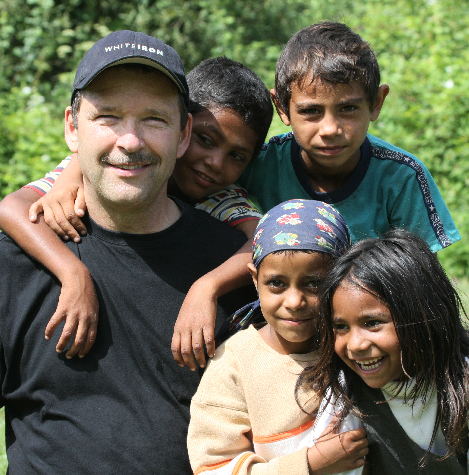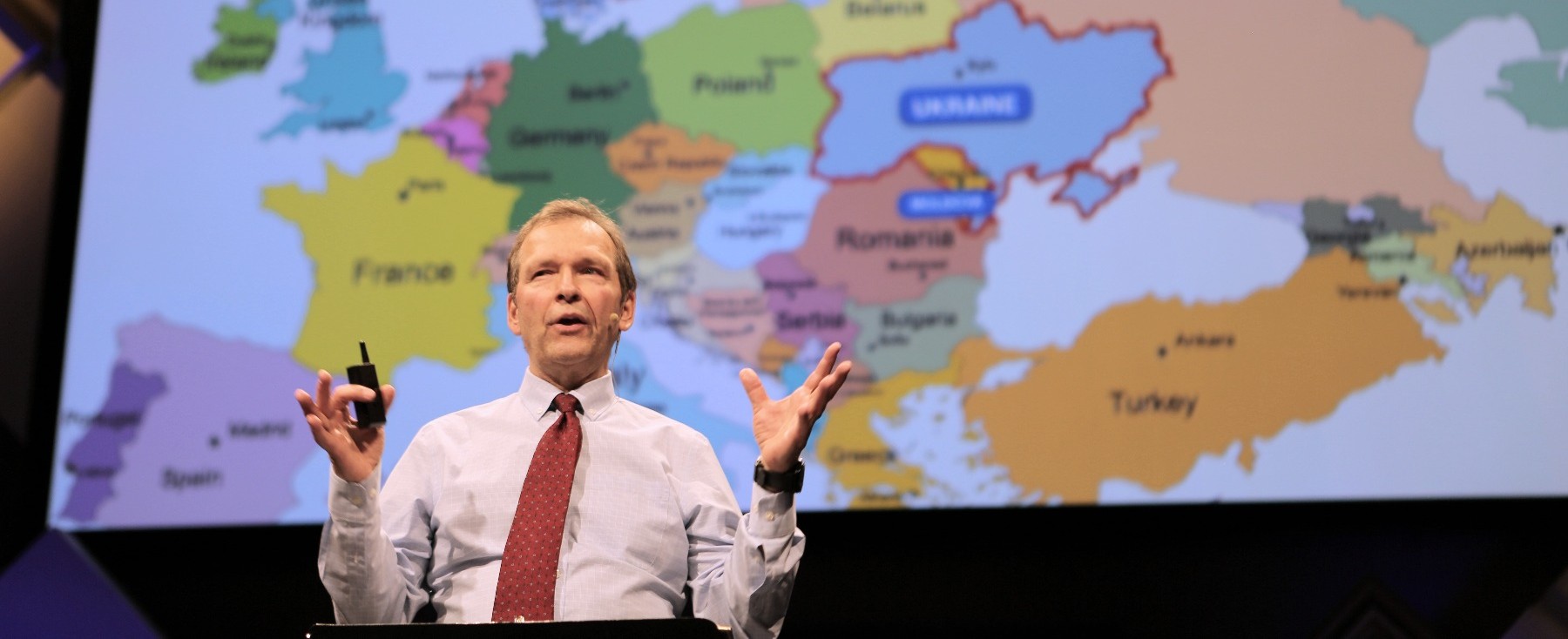Meet the Founder – Lloyd Cenaiko
In 1994, a life-changing journey to Ukraine transformed the course of Lloyd’s life. Driven by a desire to explore his family’s roots, he was deeply impacted by what he witnessed in the aftermath of the collapse of the Soviet Union.
Lloyd returned home with a newfound sense of purpose – a desire to make a meaningful difference in this part of the world. He made a bold decision to give up a successful commercial real estate development career, to launch and provide leadership for a new organization he would call HART.
“In 1994, when I transitioned from commercial real estate
development to relief aid work, I couldn’t have been
further out of my comfort zone!”
Q & A with Lloyd Cenaiko



What’s your background?
I grew up in small-town Saskatchewan, Canada, received degrees (B.Sc. and B.Ed.) from the University of Saskatchewan in Saskatoon and taught school for several years. Although I loved the kids and teaching, my entrepreneurial spirit was more inclined to flourish in the business world. The next 15 years of my life were spent as a business owner and real estate developer in Canada and the USA.
What was the genesis of HART and your work in Eastern Europe?
It began in 1994 when I accompanied my parents on a trip to Ukraine, driven by my father’s wish to revisit his birthplace and reconnect with our Ukrainian family. As someone with a keen interest in history, I saw this as a perfect opportunity to explore Eastern Europe, which had undergone significant changes since the collapse of communism in 1991 and Ukraine’s emergence as an independent nation. My grandfather’s life story was a fascinating and difficult one, culminating in him bringing his family, including my father, to Canada in 1929. However, he left behind a brother and sister in Ukraine, whose descendants we were slated to meet. I was eager to listen to their accounts of life under communism and their experiences in the wake of independence.
What were some major takeaways for you from this trip to Ukraine?
As I explored our relatives’ villages throughout the trip, I was overwhelmed by the harsh realities of life in rural Ukraine. The level of poverty I witnessed left me astonished and deeply troubled. Yet, despite their impoverished circumstances, our family displayed remarkable grace, kindness, and generosity. This experience opened my eyes to the realization that I had won the lottery – to have been born and raised in Canada, a privilege I had done nothing to earn or deserve.
How did you process all this?
As I sat on the plane bound for Canada, I had plenty of time to reflect on this ten-day trip, and I began to feel a growing sense of purpose and obligation. While the specifics were unclear, I knew deep down in my heart I needed to take action or be part of something that could help the Ukrainian people.
What happened next?
Ultimately, I faced a pivotal “fork in the road” moment. I could choose to continue my real estate career and lead a life of relative wealth and comfort in Scottsdale, Arizona. Alternatively, I could embark on a journey into completely uncharted waters, engaged in relief aid and development work, something I had virtually no experience in. I couldn’t have been further out of my comfort zone! But I somehow felt this was where I needed to be. So, in 1994-1995, I transitioned from the corporate world to the relief aid world.
So, how was HART born?
My initial strategy was to try to effect change by supporting existing relief and missions agencies already working in Ukraine. I embarked on my second trip in 1995 with one of these agencies with which I had been volunteering. However, as I took a closer look at what I was getting into, I became increasingly aware of the inefficiencies and duplication of services prevalent in the relief and missions sector during the early 1990’s. I also sensed a growing frustration among local Ukrainians, who often felt subjected to paternalistic and demanding attitudes from Western mission organizations.
Driven by a strong conviction that there had to be a better model – one that was more practical, effective, and empowering for the local population – I embarked on an extensive journey of research and prayer. This process ultimately led me to the decision to establish my own organization, HART, which was officially incorporated in Canada in 1996 and in the USA in 1998. The goal was to create an entity that could address Ukraine’s challenges in a more efficient, collaborative, and locally-driven manner, with the aim of making a tangible and sustainable impact in Ukraine and beyond.
Your model involves resourcing Nationals and their ministries/projects in Eastern Europe. How did you come up with this strategy?
This is a great question and an easy one to answer. Given my complete lack of experience in the world of international aid and missions, I decided to focus my efforts on what I felt was a fundamental and reasonable question to pose to churches and Christian leaders in Ukraine. I asked them, “How can we in the West practically and effectively help you change the hearts and minds of your people (spiritual) and help you look after widows and orphans (physical)?” Their responses to this question have served as our compass for nearly three decades. It helped us create the foundation for what HART was going to stand for.
In essence, our prime focus at HART has been to provide the support and resources that Ukrainian Christian leaders have directly told us they need rather than imposing our own assumptions or agendas. By listening to and acting upon the wisdom and insights of those on the ground, we’ve developed a more targeted, effective, and locally-driven approach to relief aid and missions.
Your model also involves partnerships with National churches and pastors. Why is this the case?
HART’s model of partnering with local Ukrainian Christian leaders and churches is the most effective approach in the world of missions today. Why? Here are a few key reasons:
COST-EFFECTIVENESS: Working directly with in-country partners who deeply understand the local context allows HART to maximize the impact of every dollar donated. This makes the aid delivery process much more cost-efficient than that of Western organizations operating alone.
SUSTAINABILITY: If the local population does not fully embrace and champion an initiative, it is unlikely to succeed in the long term. Projects driven by outsiders are prone to failure once external support is withdrawn. True sustainability only occurs when the local church and community take ownership of the projects and make them their own.
EMPOWERMENT: By centering the priorities identified by Ukrainian Christian leaders, HART ensures its work is deeply rooted in the local culture and empowers Ukrainians to drive positive change in their own communities. This avoids paternalistic approaches that can frustrate local populations.
In essence, HART’s model is premised on the belief that the most practical and effective way to create lasting change is to empower and resource local leaders and communities. This approach not only makes the best use of limited funds but also taps into the wisdom, commitment, and cultural understanding of those who are most invested in the well-being of their own people. By working in true partnership with Ukrainian churches, HART can achieve far more together than any Western organization could accomplish alone.
What does the future hold for HART? Where do you see HART going?
As HART looks to the future, our vision remains focused on empowering the Ukrainian church to become self-sufficient and thriving. When we founded HART in 1996, my hope was that we could serve as a bridge, providing support and resources during the challenging transition period following the collapse of communism. The ultimate goal was for HART to eventually work itself out of a job as the local churches gained the capacity to fully meet the needs of their communities on their own.
While the ongoing difficulties facing Ukraine make that goal seem distant in the short term, it remains a long-term aspiration that we continue to work towards. By investing in the leadership development of Ukrainian pastors and ministry leaders, strengthening the capacity of local churches, and fostering self-sustaining community initiatives, we believe the day will come when HART’s role will have run its course.
Our role is to walk alongside the Ukrainian church, providing encouragement, training, and resources, but always with an eye towards the day when they will no longer need our assistance. We pray that through our partnership, the local church will grow in its ability to transform lives, strengthen families, and meet the physical and spiritual needs of their communities. When that happens, HART will have achieved its purpose, and we will celebrate the Ukrainian church’s independence and maturity.
What do you enjoy the most about HART’s work?
The greatest joy and fulfillment in HART’s work comes from witnessing the thousands of lives transformed spiritually and practically every year through our partnerships in Ukraine. To play even a small part in this life-changing impact is a profound privilege and honor that motivates us daily.
However, what I find most rewarding about HART’s model is the opportunity it provides for North American individuals, families, small groups, and churches to make a tangible, meaningful difference in the world. By supporting HART’s initiatives, donors can directly change the destiny and life trajectory of a child, a family, or an entire community in Ukraine.
Whether it’s providing a scholarship that enables a student to attend university, equipping a church to care for orphans and widows, or empowering a family to break the cycle of poverty, every gift to HART has the power to transform lives. Donors can see the direct results of their generosity and know that their investment is being multiplied through the work of our local partners.
This ability to make a global impact through local action is what makes HART’s work so compelling. It allows North Americans to be directly involved in God’s work of redemption and restoration in Ukraine and to experience the joy of being part of something bigger than themselves. As we continue to grow, I look forward to providing more opportunities for people to make a difference in this world.
Together, we CAN change the world!
Tell us about your family?
During the summer of 1996, I was fortunate to participate in an open-air baptism ceremony at a small artificial lake in Lviv, a city in western Ukraine. Among my various responsibilities at the time was managing all of HART’s photography, so I was delighted to document numerous stunning moments from this celebratory event. Considering that good cameras were uncommon in Ukraine during that period, my plan was to later share these captured memories with the individuals I photographed. Being able to provide them with high-quality images of such a significant occasion was truly a priceless gift to cherish forever.
Over the course of several months, I gradually handed out the photos, with the final one remaining being particularly memorable. It depicted a young woman emerging from the baptismal waters, her face beaming with joy and exhilaration. It wasn’t until nearly a year later that I finally identified her at a Saturday night youth service. The next day, at church, I presented her with the photo.
That chance encounter led to an unexpected turn of events. Six years later, in 2002, that young woman and I were married. God has richly blessed Ulyana and I with three wonderful children who bring us immense joy daily. My family is the greatest gift I could ever have received from that fateful summer day in 1996 when a simple act of photography opened the door to a lifetime of love, laughter, and cherished memories.


